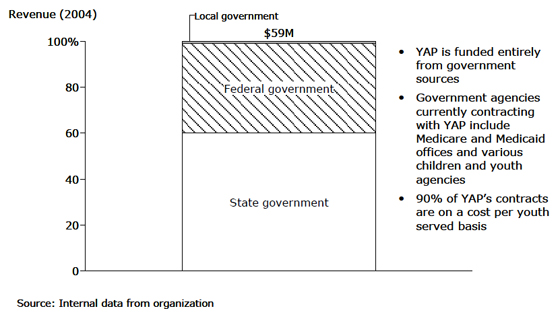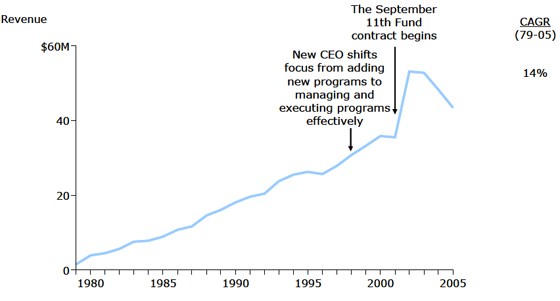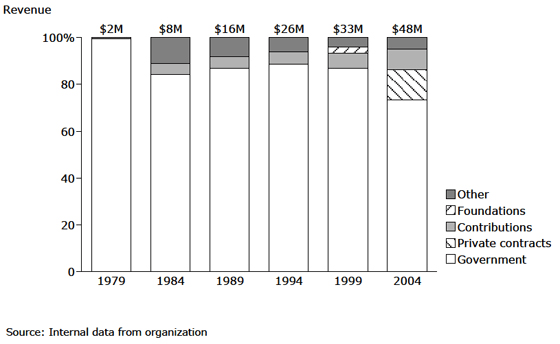You have to have a clear mission that rings true with people, and then build your culture around that mission.
– Tom Jeffers, Founder
Overview
Related Content
How Nonprofits Get Really BigOrganization Profiles from How Nonprofits Get Really Big
Youth Advocate Programs, Inc. (YAP) provides direct services to youth who are currently, have been, or are at risk of referral to incarceration and who have been rejected by all other similar service providers. Founded in 1975 in response to government demand, YAP contracts with state, city, and county referring authorities, offering a cost-effective alternative to institutional rehabilitation for adjudicated youth. Local agencies contract with YAP on a per-head cost basis.
YAP has 115 programs in 11 states and Washington D.C., with 4,100 current beneficiaries and 2,100 staff. Its programming focuses on providing marginalized youth with an opportunity to re-integrate with society through a network of community-based care providers. YAP emphasizes building on each youth’s existing strengths; accordingly, the unique circumstances of each case dictate the application of YAP’s model.
YAP is often contacted to provide services in communities where a correctional facility is being closed. The organization appoints regional or state presidents to negotiate contracts within a particular jurisdiction; the state and national offices coordinate on collection and accounting. YAP staff live in the communities where they work and reflect the ethnic and cultural makeup of their communities.
Founding date: 1975
Revenue (2004): $59 million
Structure: Single organization
NCCS classification: Human services—children and youth services
Services: Provides community-based, highly individualized direct services as an alternative to incarceration
Beneficiaries: Youth who are, have been, or may be referred to compulsory placement institutions
Leadership (selected): Jeff Fleisher, CEO; Minette Bauer, Deputy CEO
Address: 2007 North Third St., Harrisburg, PA, 17102
Website: www.yapinc.org

Growth Story
- 1975 – YAP is founded as a pilot project for serving adjudicated youth outside of an incarceration facility.
- 1976 – Philadelphia contracts with YAP. This contract funds the development of YAP’s central office.
- 1978 – New Jersey’s state government contracts with YAP.
- 1980 – The new mayor of Philadelphia does not renew YAP’s contract. YAP runs a large deficit. YAP’s founders mortgage their house, take on personal loans, and ask staff to take unemployment to keep the organization running.
- Mid-1980s – YAP begins to grow via city and county contracts in existing markets.
- Early 1990s – YAP enters New York and Texas.
- 1998 – A BBC documentary leads to the creation of YAP affiliate programs in Great Britain and Northern Ireland.
Revenue Trends
Revenue growth: YAP’s geographic expansion in the early 1990s and its increasing name recognition in the mid-1990s fueled the organization’s growth.

Funding mix: YAP is funded entirely from government sources. Its mix of government funds has shifted away from local sources and towards state and federal sources. The federal category includes federal grants passed through state agencies.

Actions That Helped Propel Growth in Funding
- Translated political crises into funding opportunities. YAP’s success has largely resulted from state crises in funding correctional systems. These crises have forced state and local officials to seek alternate and more affordable models like YAP’s.
- Relied on founders’ dedication. YAP’s founders got the organization through tough financial times in the early 1990s by sacrificing their personal finances. Their determination got the organization through its early learning curve to sustainability.
- Used data to support and market its model. YAP’s genesis as a research project provided it with proven outcomes to support its innovative model. That starting point combined with continued efforts to track data on costs and outcomes have been a crucial element of YAP’s appeal to new customers.
- Cultivated passion among frontline staff. YAP’s ability to recruit the kind of staff who could succeed in its model, and to inspire them on an ongoing basis, has been crucial to the success of its high-touch, grassroots service delivery model.
Funding Challenges
- Dealing with government contracts’ thin margins and slow payment cycles. The thin margins and the slow payment cycles associated with government contracts have placed high demands on YAP’s cash flow.
- Filling management positions from within. YAP’s unique model makes it difficult to fill management positions with outside staff. Accordingly, the ability to retain staff and promote from within has been a major constraint to YAP’s growth.

